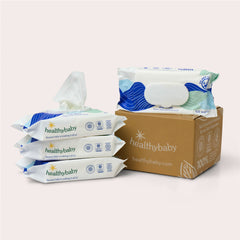There's a chill in the air, decorations outside, candy by the ton, and in some neighborhoods, multiple days of costumed festivities. It's spooky season, a magical time of year for kids and parents alike!
Whether you're planning a cutesy family costume or chaperoning creepier characters on their trick-or-treating adventures, a few thoughtful swaps can protect your family from the truly scary stuff, like forever chemicals, while sparking creativity and imaginative play.
Keep reading for 5 tricks and treats for a Happy Halloclean!

1. Make your own costumes
Store-bought costumes are pricey, less imaginative, and usually made of synthetic materials that can irritate skin and allergies in the short-term and wreak environmental havoc in the long-term.
If you can, try to make Halloween costumes with items you already have at home, including cardboard that's sitting in your recycling bin. If you need something new, visit a resale or thrift shop to shop secondhand. This gives kids a chance to be involved in the creation process.
While we're on the topic of costumes, consider developmental appropriateness and creativity. More general costumes, like animals or classic storybook characters (fairy, pirate, princess), are great for younger kids and can be used again and again for pretend-play. Older kids looking to score points for originality—and possibly win a costume contest—can have fun dressing as a favorite book or movie character, historical figure, or everyday item.
2. Swap costumes with friends
If you don't have time to make new costumes, consider swapping old ones with friends or neighbors with kids of a similar age and size. Just be careful about wearing store-bought masks that may contain latex or other skin irritants and can limit visibility and breathability when worn.
Costume swapping promotes sustainability by giving old costumes new life, and also shows littles ones the power of sharing and community.
3. Choose clean Halloween makeup
If you're painting your child's face to accentuate their costume, choose non-toxic face paints (or cosmetics, if you need to save some time). You can make your own fairly easily.
Ingredients:
1 teaspoon of cornstarch
1/2 teaspoon of shortening or cold cream
1/2 teaspoon of water
A few drops of plant-based food coloring
Directions:
1. Combine cornstarch, shortening or cold cream, and water in a small bowl.
2. Mix until you have a smooth paste.
3. Add plant-based food coloring until the desired color is achieved and stir to distribute the color evenly.
4. Opt for eco-friendly Halloween decorations
Store-bought Halloween decorations are often made of unsustainable materials that are harmful for wildlife (for example, birds can get caught in synthetic spiderwebs displayed outside). Try making your own decorations at home as a family, using biodegradable or recyclable items.
A few ideas:
- Leaf garlands: Gather colorful fall leaves on a family walk. Let your child design the order leaves should go in and string them together with natural twine to make a garland. At the end of the season, you can take the leaves outside to biodegrade into mulch or toss the entire garland in your compost bin.
- DIY lanterns: Recycle glass jars and use them to make Halloween lanterns. Your child can decorate the jars with non-toxic paint or tissue paper and add LED tea lights for a safe glow.
- Pumpkin-palooza: Arrange pumpkins in an artful way inside or outside your home. If you don't carve or paint them, gourds can be on display throughout the fall and winter. When you're ready to part with your pumpkins, consider roasting and eating them, cutting them up and leaving them out for wildlife if this is permitted in your area, or composting them.
5. Consider your Halloween candy
Sweet treats are a Halloween staple, but there are more mindful ways to enjoy them. If you're passing out store-bought candy, look for more sustainably packaged goodies. Candy in cardboard boxes, like Milk Duds or Whoppers, can be enjoyed and easily recycled. Individually foil-wrapped Hershey's Kisses are another recycleable option.
Not feeling the candy? Think about passing out other non-toxic and kid-friendly items, like crayons, stickers, erasers, or homemade slime or play-dough. Try to use reusable or recycleable packaging for whatever you give out.




